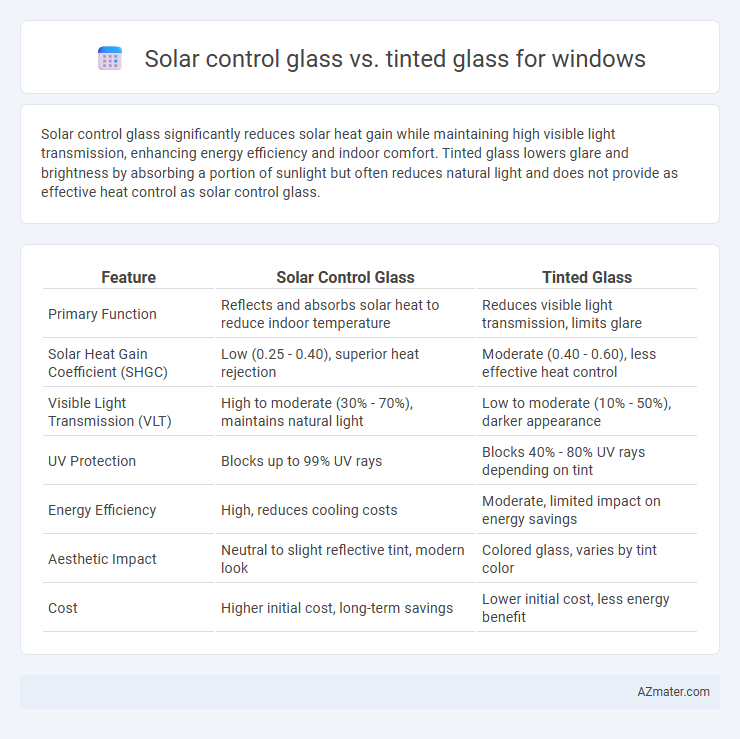Solar control glass significantly reduces solar heat gain while maintaining high visible light transmission, enhancing energy efficiency and indoor comfort. Tinted glass lowers glare and brightness by absorbing a portion of sunlight but often reduces natural light and does not provide as effective heat control as solar control glass.
Table of Comparison
| Feature | Solar Control Glass | Tinted Glass |
|---|---|---|
| Primary Function | Reflects and absorbs solar heat to reduce indoor temperature | Reduces visible light transmission, limits glare |
| Solar Heat Gain Coefficient (SHGC) | Low (0.25 - 0.40), superior heat rejection | Moderate (0.40 - 0.60), less effective heat control |
| Visible Light Transmission (VLT) | High to moderate (30% - 70%), maintains natural light | Low to moderate (10% - 50%), darker appearance |
| UV Protection | Blocks up to 99% UV rays | Blocks 40% - 80% UV rays depending on tint |
| Energy Efficiency | High, reduces cooling costs | Moderate, limited impact on energy savings |
| Aesthetic Impact | Neutral to slight reflective tint, modern look | Colored glass, varies by tint color |
| Cost | Higher initial cost, long-term savings | Lower initial cost, less energy benefit |
Introduction to Window Glass Technologies
Solar control glass enhances energy efficiency by filtering infrared and ultraviolet rays while maintaining natural light transmission, reducing cooling costs significantly. Tinted glass primarily absorbs and reduces visible light intensity, providing glare reduction and privacy but often compromising interior brightness. Advances in window glass technologies combine coatings and tints to optimize thermal performance and aesthetic appeal for modern architectural applications.
Understanding Solar Control Glass
Solar control glass is engineered with special coatings that reflect and absorb solar radiation, significantly reducing heat gain while maintaining natural light transmission, unlike traditional tinted glass which primarily darkens windows to reduce glare without effectively controlling heat. This technology enhances energy efficiency by lowering cooling costs and improves indoor comfort, making it ideal for commercial and residential buildings seeking sustainable solutions. Solar control glass also helps protect interior furnishings from UV damage, a benefit tinted glass often lacks.
What is Tinted Glass?
Tinted glass is a type of window glass that contains additives or dyes during manufacturing to reduce glare and solar heat by absorbing a portion of the sunlight. It offers enhanced privacy, reduces UV radiation, and improves energy efficiency by lowering cooling costs in buildings and vehicles. Compared to solar control glass, tinted glass primarily relies on its coloration to block light rather than specialized coatings designed for maximum heat rejection.
Key Differences Between Solar Control and Tinted Glass
Solar control glass is designed with a special coating that reflects infrared heat while allowing visible light to pass through, significantly reducing solar heat gain and improving energy efficiency in buildings. Tinted glass incorporates colorants or dyes that absorb a portion of sunlight, reducing glare and visible light transmission but often allowing more heat to pass through compared to solar control glass. Key differences include solar heat rejection, with solar control glass providing superior thermal performance, and aesthetic variation, as tinted glass changes window color whereas solar control glass maintains clearer visibility.
Energy Efficiency Comparison
Solar control glass reduces heat gain by blocking a significant portion of infrared radiation while allowing natural light, enhancing energy efficiency through lower cooling loads compared to standard tinted glass. Tinted glass absorbs and reduces visible light transmission but often traps heat inside, which can increase cooling energy consumption in warmer climates. Studies indicate solar control coatings can decrease building energy costs by up to 30%, outperforming traditional tinted glass in both thermal comfort and energy savings.
Light Transmission and Glare Reduction
Solar control glass offers superior light transmission by selectively filtering infrared rays while allowing ample visible light, resulting in reduced heat gain without compromising natural illumination. Tinted glass reduces overall light transmission evenly across the visible spectrum, leading to darker interiors but less effective glare reduction compared to solar control glass. The spectral properties of solar control glass provide enhanced glare reduction by blocking specific wavelengths, optimizing comfort and energy efficiency in window applications.
UV Protection Capabilities
Solar control glass provides superior UV protection by blocking up to 99% of harmful ultraviolet rays, reducing interior fading and enhancing occupant safety. Tinted glass primarily reduces glare and visible light transmission but offers limited UV protection, often allowing more UV radiation to penetrate. Choosing solar control glass ensures optimal UV defense while maintaining natural light, making it ideal for residential and commercial windows.
Cost and Installation Considerations
Solar control glass typically costs more upfront than tinted glass due to advanced coatings that reflect infrared and UV rays, offering superior energy efficiency. Installation of solar control glass may require professional expertise to ensure proper sealing and performance, potentially increasing labor costs. Tinted glass is generally less expensive and easier to install, making it a budget-friendly option but with lower heat rejection and energy savings compared to solar control glass.
Best Applications for Each Glass Type
Solar control glass is ideal for commercial buildings and homes in hot climates, effectively reducing heat gain and minimizing energy costs with its advanced coatings that reflect infrared radiation. Tinted glass suits residential and automotive windows where privacy and glare reduction are prioritized, offering a variety of color options to enhance aesthetics while providing moderate heat and UV protection. Choosing the right glass depends on balancing thermal performance with visual comfort and design preferences specific to the application.
Conclusion: Choosing the Right Glass for Your Windows
Solar control glass effectively reduces heat gain and UV radiation while maintaining natural light, making it ideal for energy-efficient buildings. Tinted glass primarily lowers glare and enhances privacy but allows more heat transmission compared to solar control variants. Selecting the right glass depends on balancing energy savings, light preference, and aesthetic needs for optimal window performance.

Infographic: Solar control glass vs Tinted glass for Window
 azmater.com
azmater.com